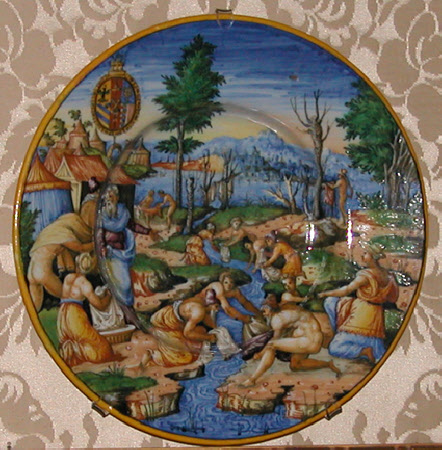Plate
Category
Ceramics
Date
1559 - 1574
Materials
earthenware, tin-glazed (maiolica), inglaze pigments
Measurements
27 cm (Diameter)
Place of origin
Urbino
Order this imageCollection
Ickworth, Suffolk
NT 848730
Summary
Set of three dishes with the arms of the Duke of Urbino, made in the workshop of Guido Fontana, Urbino, Italy, around 1559-74. Three different designs.
Full description
In the sixteenth century, Italian maiolica tablewares decorated with colourful 'istoriato' or 'figurato' (story or figure) painting were exported throughout Europe. Some may have furnished the sumptuous banqueting tables of Henry VIII, to judge from a reference in a 1542 inventory of Whitehall Palace: ‘Item oone Picture of St John hed in a dish of Erthe’.[1] By 1600, when production in Italy had shifted to plain white wares, known as bianchi di Faenza, an élite second-hand market arose for the earlier, Renaissance wares. For example, in 1670, John Dodington, the British diplomat resident at Venice, acting as a commercial agent, offered maiolica, as well as a marble sculpture by Donatello, to Henry Bennet, 1st Earl of Arlington, who was buying on behalf of Charles II.[2] Four mid-16th century maiolica dishes now at Ickworth are of a particular interest because of evidence that at least three of them, made about 1559–74, were apparently acquired by the early Grand Tourist and pioneering English collector Thomas Howard, 21st Earl of Arundel (1585–1646), and his wife, Alethea (1585–1654), presumably on one of their frequent visits to Italy from 1613.[3] The dishes were bought by John Hervey, 2nd Baron Hervey (1696–1743), of Ickworth, Suffolk, at the auction in 1742 of Edward Harley, 2nd Earl of Oxford and Earl Mortimer (1689–1741), of Welbeck Abbey, Nottinghamshire, and Wimpole Hall, Cambridgeshire (nt). Harley was a patron of the arts and a great bibliophile – his collection of manuscripts forms the core of the British Library. At the five-day sale held by the auctioneer Christopher Cock at his rooms in Covent Garden, Lord Hervey bought ‘Four Roman earthen Plates, out of the Arundel Collection (1 broke)’ for £6 12s 6d.[4] The term ‘Roman earthen ware’ was historically used to describe Italian maiolica. Today there are four maiolica dishes at Ickworth. Three are painted with the arms of Guidobaldo II della Rovere, Duke of Urbino, who ruled from 1538 to 1574. The Duke ordered the large service from a workshop operated by Guido Fontana (also known as Guido Durantino), active from 1519 to 1576, as a gift for the Augustinian friar and celebrated preacher Andrea Ghetti da Volterra (1505/10–78).[5] The subjects, based on the titles inscribed on the reverse, are as follows: Moses and the Israelites washing their clothes (Exodus 19); Camillo weighing the spoils of Veii, a wealthy Etruscan town near Rome; and Aaron dressed in the high priest’s robes (Exodus 39 or 38).[6] The Old Testament scenes are based on woodblock prints in 'Quadrins historiques de la Bible' by Claude Paradins, published in Lyon in 1553. One of the four dishes bought by Lord Hervey was described as ‘broke’, however, none of the four appears to have been broken. As the fourth Ickworth dish is much larger and from a different workshop it may not have been part of the 1742 acquisition (fig. 1). It depicts a New Testament subject, ‘The Narrow and the Wide Path’ (Matthew 7:13), with a lengthy inscription on the front and reverse. It is signed with the initials ‘L.F’ and dated ‘1550’ on a rock, also repeated on the underside.[7] An 1899 inventory of Ickworth records ‘Three 11 in. china plates, painted, Roman Scenes’ and ‘A 16 in. Delft ware plate, painted, The Road to Heaven, in Drawing Room’.[8] Shortly after, the four dishes were mounted in two glazed, giltwood faux-tortoiseshell painted frames and hung in the library as part of the refurbishments funded by the 4th Marchioness of Bristol, the railway heiress Theodora Hervey, née Wythes (1875–1957).[9] [1] Maria Hayward (ed.), The 1542 Inventory of Whitehall: The Palace and its Keeper (London, 2004), no. 834. [2] Helen Jacobsen, Luxury and Power: The Material World of the Stuart Diplomat, 1660–1714 (Oxford, 2011), p. 123. [3] The ‘two cisterns to sett bottles in of white Earth, & two Earthen bottels wth Long neckes & Covers’, listed in a 1641 inventory of Tart Hall, home of the Countess of Arundel, may have been bianchi di Faenza: see Sir Lionel Cust, ‘Notes on the Collections formed by Thomas Howard, Earl of Arundel and Surrey K.G. – ii’, The Burlington Magazine, 20, no. 104 (November 1911), pp. 97–100, at p. 99. [4] 8 March 1742, lot 16: A.V.B. Norman, Wallace Collection: Catalogue of Ceramics 1: Pottery, Maiolica, Faience, Stoneware (London, 1976). p. 23. I thank Kate Hill for this reference. [5] Elisabeth Reissinger, Italienische Majolika, Kunstsammlungen zu Weimar (Berlin, 2000), nos. 23–28; and Alice Sunderland Wethey, ‘A Historiated Majolica Serving Platter’, Bulletin of the Detroit Institute of Art, 58, no. 1 (1980), pp. 37–45. [6] Wilson 2002, p. 152. I thank J.V.G. Mallet for this reference. [7] NT 848729. I thank Julia E. Poole, Berthold Kress and Timothy Wilson for their generous assistance. [8] Ickworth Muniments. [9] NT 850205 and NT 850410. Adapted from Patricia F. Ferguson, Ceramics: 400 Years of British Collecting in 100 Masterpieces, Philip Wilson Publishers, 2016.
References
Ferguson 2016: Patricia F. Ferguson, Ceramics: 400 Years of British Collecting in 100 Masterpieces, Philip Wilson Publishers, 2016, pp.18-19


